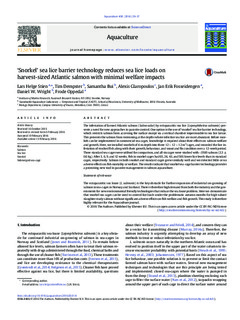| dc.contributor.author | Stien, Lars Helge | |
| dc.contributor.author | Dempster, Timothy David | |
| dc.contributor.author | Bui, Samantha | |
| dc.contributor.author | Glaropoulos, Alexis | |
| dc.contributor.author | Fosseidengen, Jan Erik | |
| dc.contributor.author | Wright, Daniel W. | |
| dc.contributor.author | Oppedal, Frode | |
| dc.date.accessioned | 2016-08-24T12:08:13Z | |
| dc.date.accessioned | 2016-09-21T13:01:09Z | |
| dc.date.available | 2016-08-24T12:08:13Z | |
| dc.date.available | 2016-09-21T13:01:09Z | |
| dc.date.issued | 2016-02-13 | |
| dc.identifier.citation | Aquaculture 2016, 458:29-37 | nb_NO |
| dc.identifier.issn | 0044-8486 | |
| dc.identifier.uri | http://hdl.handle.net/11250/2409383 | |
| dc.description | - | nb_NO |
| dc.description.abstract | The infestation of farmed Atlantic salmon (Salmo salar) by ectoparasitic sea lice (Lepeophtheirus salmonis) presents a need for new approaches to parasite control. One option is the use of ‘snorkel’ sea lice barrier technology, which restricts salmon from accessing the surface except via a vertical chamber impermeable to sea lice larvae. This prevents the salmon from swimming at the depths where infective sea lice are most abundant. Before snorkels can be implemented in commercial sea-cages, knowledge is required about their effects on salmon welfare and growth. Here, we installed snorkels of 4 m depth into three 12 × 12 × 12 m3 cages, and recorded the lice infestation of stocked fish along with their growth, behaviour, and snout and fin condition over a 12-week period. Three standard sea-cages were utilised for comparison, and all six cages were stocked with ~ 3500 salmon (2.3 ± 0.6 kg). After 3, 6, 9, and 12 weeks, fish in snorkel cages had 65, 24, 43, and 56% lower lice levels than in standard cages, respectively. Salmon in both snorkel and standard cages grew similarly well and we detected little or no adverse effects on fish mortality or welfare. The results indicate that snorkel sea-cage barrier technology provides a promising new tool in parasite management in salmon aquaculture. | nb_NO |
| dc.language.iso | eng | nb_NO |
| dc.publisher | Elsevier | nb_NO |
| dc.rights | Navngivelse-DelPåSammeVilkår 3.0 Norge | * |
| dc.rights.uri | http://creativecommons.org/licenses/by-sa/3.0/no/ | * |
| dc.title | 'Snorkel' sea lice barrier technology reduces sea lice loads on harvest-sized Atlantic salmon with minimal welfare impacts | nb_NO |
| dc.type | Journal article | nb_NO |
| dc.type | Peer reviewed | nb_NO |
| dc.date.updated | 2016-08-24T12:08:13Z | |
| dc.subject.nsi | VDP::Landbruks- og fiskerifag: 900::Fiskerifag: 920::Fiskehelse : 923 | nb_NO |
| dc.subject.nsi | VDP::Agriculture and fisheries science: 900::Fisheries science: 920::Fish health: 923 | nb_NO |
| dc.source.pagenumber | 29-37 | nb_NO |
| dc.source.volume | 458 | nb_NO |
| dc.source.journal | Aquaculture | nb_NO |
| dc.identifier.doi | 10.1016/j.aquaculture.2016.02.014 | |
| dc.identifier.cristin | 1368958 | |
| dc.relation.project | Fiskeri- og havbruksnæringens forskningsfond: 900884 | nb_NO |

